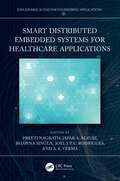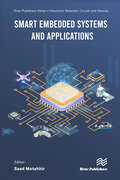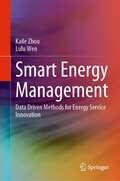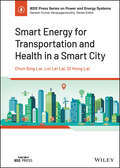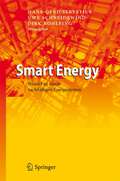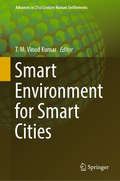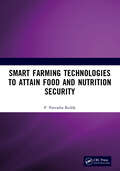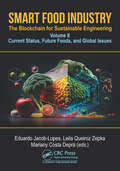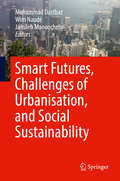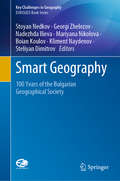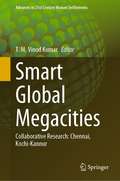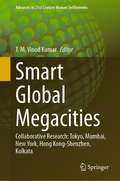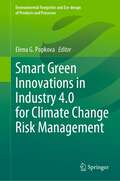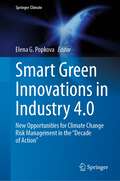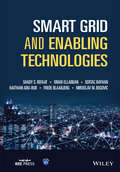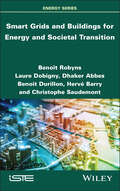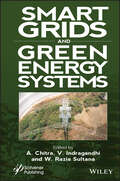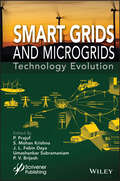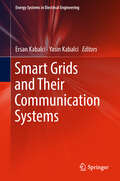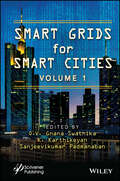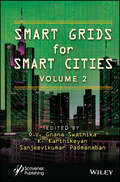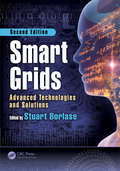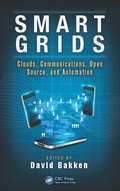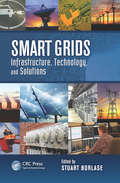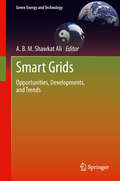- Table View
- List View
Smart Distributed Embedded Systems for Healthcare Applications (Explainable AI (XAI) for Engineering Applications)
by Jafar A. Alzubi Joel J. P. C. Rodrigues Bhawna Singla Preeti Nagrath A. K. VermaThis book discusses the applications and optimization of emerging smart technologies in the field of healthcare. It further explains different modeling scenarios of the latest technologies in the healthcare system and compares the results to better understand the nature and progress of diseases in the human body, which would ultimately lead to early diagnosis and better treatment and cure of diseases with the help of distributed technology. Covers the implementation models using technologies such as artificial intelligence, machine learning, and deep learning with distributed systems for better diagnosis and treatment of diseases. Gives in-depth review of technological advancements like advanced sensing technologies such as plasmonic sensors, usage of RFIDs, and electronic diagnostic tools in the field of healthcare engineering. Discusses possibilities of augmented reality and virtual reality interventions for providing unique solutions in medical science, clinical research, psychology, and neurological disorders. Highlights the future challenges and risks involved in the application of smart technologies such as cloud computing, fog computing, IOT, and distributed computing in healthcare. Confers to utilize the AI and ML and associated aids in healthcare sectors in the post-Covid 19 period to revitalize the medical setup. Contributions included in the book will motivate technological developers and researchers to develop new algorithms and protocols in the healthcare field. It will serve as a vast platform for gaining knowledge regarding healthcare delivery, health- care management, healthcare in governance, and health monitoring approaches using distributed environments. It will serve as an ideal reference text for graduate students and researchers in diverse engineering fields including electrical, electronics and communication, computer, and biomedical fields.
Smart Embedded Systems and Applications
by Saad MotahhirThis book covers a wide range of challenges, technologies and state-of-the-art for the design, development and realization of smart and complex embedded systems and their applications; i.e., software and hardware development, with the use of digital technologies, and quality assurance for critical applications. This book starts with automotive safety systems which is one of the major functional domains. It discusses the importance of software in automotive systems followed by an insight into Automotive Software Standards, ISO26262, and Autosar. The book further discusses the use of Processor in the loop test for an adaptive trajectory tracking control for quadrotor UAVs. It also illustrates the role of embedded systems in medical engineering. Various innovative applications involving the concept of image processing and Internet of Things are also presented in this book. The SoC Power Estimation is also investigated. Finally, a Review of the Hardware/Software Partitioning Algorithms with some future works have been presented. this book is intended for academicians, researchers, and industrialists.
Smart Energy Management: Data Driven Methods for Energy Service Innovation
by Kaile Zhou Lulu WenThis book provides a relatively whole view of data-driven decision-making methods for energy service innovation and energy system optimization. Through personalized energy services provision and energy efficiency improvement, the book can contribute to the green transformation of energy system and the sustainable development of the society. The book gives a new way to achieve smart energy management, based on various data mining and machine learning methods, including fuzzy clustering, shape-based clustering, ensemble clustering, deep learning, and reinforcement learning. The applications of these data-driven methods in improving energy efficiency and supporting energy service innovation are presented. Moreover, this book also investigates the role of blockchain in supporting peer-to-peer (P2P) electricity trading innovation, thus supporting smart energy management. The general scope of this book mainly includes load clustering, load forecasting, price-based demand response, incentive-based demand response, and energy blockchain-based electricity trading. The intended readership of the book includes researchers and engineers in related areas, graduate and undergraduate students in university, and some other general interested audience. The important features of the book are: (1) it introduces various data-driven methods for achieving different smart energy management tasks; (2) it investigates the role of data-driven methods in supporting various energy service innovation; and (3) it explores energy blockchain in P2P electricity trading, and thus supporting smart energy management.
Smart Energy for Transportation and Health in a Smart City (IEEE Press Series on Power and Energy Systems)
by Loi Lei Lai Chun Sing Lai Qi Hong LaiSmart Energy for Transportation and Health in a Smart City A comprehensive review of the advances of smart cities’ smart energy, transportation, infrastructure, and health Smart Energy for Transportation and Health in a Smart City offers an essential guide to the functions, characteristics, and domains of smart cities and the energy technology necessary to sustain them. The authors—noted experts on the topic—include theoretical underpinnings, practical information, and potential benefits for the development of smart cities. The book includes information on various financial models of energy storage, the management of networked micro-grids, coordination of virtual energy storage systems, reliability modeling and assessment of cyber space, and the development of a vehicle-to-grid voltage support. The authors review smart transportation elements such as advanced metering infrastructure for electric vehicle charging, power system dispatching with plug-in hybrid electric vehicles, and best practices for low power wide area network technologies. In addition, the book explores smart health that is based on the Internet of Things and smart devices that can help improve patient care processes and decrease costs while maintaining quality. This important resource: Examines challenges and opportunities that arise with the development of smart cities Presents state-of-the-art financial models of smart energy storage Clearly explores elements of a smart city based on the advancement of information and communication technology Contains a review of advances in smart health for smart cities Includes a variety of real-life case studies that illustrate various components of a smart city Written for practicing engineers and engineering students, Smart Energy for Transportation and Health in Smart Cities offers a practical guide to the various aspects that create a sustainable smart city.
Smart Energy: Wandel zu einem nachhaltigen Energiesystem
by Dirk Rohlfing Hans-Gerd Servatius Uwe SchneidewindNamhafte Autoren aus Wissenschaft und Praxis beschreiben in diesem Buch, wie der Wandel des Energiesektors in Richtung auf mehr Nachhaltigkeit gelingen kann. Eine wichtige Rolle spielen dabei die sogenannten Smart-Technologien. In Kapiteln zu neuen Geschäftsmodellen, intelligenten Gebäuden, der Transformation zu Smart Grids, Smart Cities und Elektromobilität vermitteln die Autoren ihre neu gewonnenen Erkenntnisse auf den Gebieten Innovationsmanagement und Nachhaltigkeitsforschung sowie ihre Erfahrung mit zukunftsweisenden Projekten im Energiesektor.
Smart Environment for Smart Cities (Advances in 21st Century Human Settlements)
by T.M. Vinod KumarThis book discusses the design and practice of environmental resources management for smart cities. Presenting numerous city case studies, it focuses on one specific environmental resource in each city. Environmental resources are commonly owned properties that require active inputs from the government and the people, and in any smart city their management calls for a synchronous combination of e-democracy, e-governance and IOT (Internet of Things) systems in a 24/7 framework. Smart environmental resources management uses information and communication technologies, the Internet of Things, internet of governance (e-governance) and internet of people (e-democracy) along with conventional resource management tools to achieve coordinated, effective and efficient management, development, and conservation that equitably improves ecological and economic welfare, without compromising the sustainability of development ecosystems and stakeholders.
Smart Farming Technologies to Attain Food and Nutrition Security
by P. Parvatha ReddyThe concept of Rainbow Revolution is an integrated development of crop cultivation, horticulture, forestry, fishery, poultry, animal husbandry, and food processing industry. The concept of Smart Farming Technologies in agriculture is a step towards sustainability. India has already achieved resilience in agriculture, including the horticultural sector, through effective agricultural technology generation and is now on the threshold of a “rainbow revolution” that will ensure both household nutrition security and prosperity for its people. This book will be of immense value to the scientific community involved in teaching, research and extension activities related to strategies for achieving Rainbow Revolution for enhancing farmers’ income, food, and nutrition security. The book can also serve as a very useful reference for policymakers and practicing farmers.
Smart Food Industry: Volume II - Current Status, Future Foods, and Global Issues
by Eduardo Jacob-Lopes Leila Queiroz Zepka Mariany Costa DepráSmart Food Industry: The Blockchain for Sustainable Engineering, Volume II - Current Status, Future Foods, and Global Issues reviews the literature and scientific frameworks to present a kind of sustainability compass. Disruptive approaches around potential sustainable foods are also widely investigated in order to be an alternative route for the industrial future. Thus, this book proposes new concepts and strategies to face future sustainability challenges that are on the horizon and can impact the next generation of foods.Divided into three parts, this book discusses the (i) status of sustainable food industry, (ii) next generation and future technology for sustainable foods, and (iii) policy, social, economic, and environmental aspects in food industries.Given the book's breadth, it provides readers with an invaluable reference resource for students, researchers, graduates, and professionals, in general, who wish to gain knowledge about the engineering and food processing area so as to achieve sustainable food production.
Smart Futures, Challenges of Urbanisation, and Social Sustainability
by Mohammad Dastbaz Wim Naudé Jamileh ManoochehriThis book tackles the challenges posed by accelerating urbanization, and demystifies Social Sustainability, the least understood of all the different areas of sustainable development. The volume’s twin focus on these profoundly intertwined topics creates a nuanced and vitally important resource. Large migrations from rural areas to cities without appropriate planning and infrastructure improvements, including housing, education and health care optimization, have created significant challenges across the globe. The authors suggest technology-rich strategies to meet these challenges by careful application of data on population growth and movement to the planning, design, and construction of operational infrastructures that can sustainably support our increasingly rapid population growth.
Smart Geography: 100 Years of the Bulgarian Geographical Society (Key Challenges in Geography)
by Boian Koulov Georgi Zhelezov Stoyan Nedkov Nadezhda Ilieva Mariyana Nikolova Kliment Naydenov Steliyan DimitrovThis book focuses on new and innovative spatial approaches based on smart solutions and developed in the field of geography and related interdisciplinary fields such as urban and regional studies, landscape ecology and ecosystem services. It includes contributions from a conference dedicated to the 100th anniversary of the Bulgarian Geographical Society.In turn, the book reveals how 21st-century geography is expected to facilitate the development of human capital and the knowledge society, while also offering place-specific solutions for sustainable regional development and utilization of the planet’s natural and human capital to improve social wellbeing. This volume is intended for the global geographical research community, as well as professionals and practitioners in all fields that deal with space, including regional planners and environmental managers.
Smart Global Megacities: Collaborative Research: Chennai, Kochi-Kannur (Advances in 21st Century Human Settlements)
by T. M. Vinod KumarThis book, the second volume, highlights 7 out of a total of about 36 megacities in the World which by definition have 10 million inhabitants. The cities/chapters presented in this book are based on recent advance such as the wide use of ICT, IOT, e-Governance, e-Democracy, smart economy and flattening and acceleration of the world that is taking place in recent times as reported by 3 times Pulitzer Prize Winner Thomas Friedman. It therefor departs from other ideologies where only a certain megacity qualifies for the title of smart global megacities while in reality every megacity can, and presents how smart global megacities can be created.
Smart Global Megacities: Collaborative Research: Tokyo, Mumbai, New York, Hong Kong-Shenzhen, Kolkata (Advances in 21st Century Human Settlements)
by T. M. Vinod KumarThis book, the first volume, highlights 8 out of a total of about 36 megacities in the World which by definition have 10 million inhabitants. The cities/chapters presented in this book are based on recent advance such as the wide use of ICT, IOT, e-Governance, e-Democracy, smart economy and flattening and acceleration of the world that is taking place in recent times as reported by 3 times Pulitzer Prize Winner Thomas Friedman. It therefor departs from other ideologies where only a certain megacity qualifies for the title of smart global megacities while in reality every megacity can, and presents how smart global megacities can be created.
Smart Green Innovations in Industry 4.0 for Climate Change Risk Management (Environmental Footprints and Eco-design of Products and Processes)
by Elena G. PopkovaThis book is devoted to strengthening the theoretical and methodological basis, systematization of international experience, and scientific elaboration of prospects for developing a climate-smart economy and business as a vector of the sustainable development of Industry 4.0 in the Decade of Action. The first part of the book focuses on climate-responsible entrepreneurship in support of the sustainable development of Industry 4.0. The part systematizes best practices for climate-smart green innovations across sectors of the digital economy. The third part reveals the experience of climate risk management based on smart green innovations in regions and countries. Particular attention is paid to the best practices of the European Union (EU) and the Eurasian Economic Union (EAEU). The book ends with part four, which explores ESG climate risk management and green finance in support of combating climate change. The book’s novelty is that it rethinks the environmental footprints of Industry 4.0 from the perspective of climate risks and their management. The theoretical significance of the book lies in the formation of an innovative concept of climate change risk management, in which the economy, society, nature, and technology are presented and interact effectively. The book is intended for scientists. In this book, they will find an innovative and systemic vision of smart green innovations in Industry 4.0 for climate change risk management.
Smart Green Innovations in Industry 4.0: New Opportunities for Climate Change Risk Management in the “Decade of Action” (Springer Climate)
by Elena G. PopkovaThis book is concerned with the study of climate change from the perspective of risks for the economy and business. Rethinking climate change from a risk perspective allows making a significant transition from the consideration of climate as a predetermined and permanent context to its interpretation as a factor that influences the economy and business. Thanks to the new risk perspective on climate change, the book offers opportunities and offers recommendations for adapting businesses and economic sectors to climate risks.As a forward-looking response (management measure) to the risks of climate change in the economy and business, this book suggests using smart green innovations in Industry 4.0 – high technologies in support of the sustainable development goals (SDGs). The advantage of smart technologies to combat climate change is their increased flexibility and adaptability, as well as the resistance of smart (automated, robotic) machines to different environmental conditions.The academic significance of the book is attributable to the fact that it covers, as widely and comprehensively as possible, the full range of ground-breaking smart green innovations in Industry 4.0 with a potential of climate change risk management: from green finance (for example, blockchain-based cryptocurrencies) to smart and clean energy, as well as smart industrial innovations in Industry 4.0. The combination of public and corporate risk management measures of climate change allows achieving a “synergetic effect” in the form of enhanced support for the implementation of the SDGs.
Smart Grid and Enabling Technologies (Wiley - IEEE)
by Haitham Abu-Rub Omar Ellabban Frede Blaabjerg Sertac Bayhan Shady S Refaat Miroslav BegovicDiscover foundational topics in smart grid technology as well as an exploration of the current and future state of the industry As the relationship between fossil fuel use and climate change becomes ever clearer, the search is on for reliable, renewable and less harmful sources of energy. Sometimes called the electronet or the energy Internet, smart grids promise to integrate renewable energy, information, and communication technologies with the existing electrical grid and deliver electricity more efficiently and reliably. Smart Grid and Enabling Technologies delivers a complete vision of smart grid technology and applications, including foundational and fundamental technologies, the technology that enables smart grids, the current state of the industry, and future trends in smart energy. The book offers readers thorough discussions of modern smart grid technology, including advanced metering infrastructure, net zero energy buildings, and communication, data management, and networks in smart grids. The accomplished authors also discuss critical challenges and barriers facing the smart grid industry as well as trends likely to be of import in its future development. Readers will also benefit from the inclusion of: A thorough introduction to smart grid architecture, including traditional grids, the fundamentals of electric power, definitions and classifications of smart grids, and the components of smart grid technology An exploration of the opportunities and challenges posed by renewable energy integration Practical discussions of power electronics in the smart grid, including power electronics converters for distributed generation, flexible alternating current transmission systems, and high voltage direct current transmission systems An analysis of distributed generation Perfect for scientists, researchers, engineers, graduate students, and senior undergraduate students studying and working with electrical power systems and communication systems. Smart Grid and Enabling Technologies will also earn a place in the libraries of economists, government planners and regulators, policy makers, and energy stakeholders working in the smart grid field.
Smart Grids and Buildings for Energy and Societal Transition
by Benoît Robyns Christophe Saudemont Hervé Barry Dhaker Abbes Laure Dobigny Benoit DurillonThis book presents interdisciplinary approaches to help buildings, electrical energy networks and their users contribute to the energy and societal transition. Smart Grids and Buildings for Energy and Societal Transition examines the technologies, uses and imaginaries involved in implementing smart buildings and smart grids. Production and consumption forecasts, modeling of stakeholder involvement and self-consumption within a renewable energy community exploiting blockchain technology are examples developed with a view to fostering the emergence of smart grids. The potential of smart buildings, taking into account user comfort while increasing energy efficiency, is identified. Full-scale demonstrators are used to test the proposed solutions, and to ensure that users take full advantage of the potential for electrical flexibility.
Smart Grids and Green Energy Systems
by A. Chitra V. Indragandhi W. Razia SultanaSMART GRIDS AND GREN ENERGY SYSTEMS Green energy and smart grids are two of the most important topics in the constantly emerging and changing energy and power industry. Books like this one keep the veteran engineer and student, alike, up to date on current trends in the technology and offer a reference for the industry for its practical applications. Smart grids and green energy systems are promising research fields which need to be commercialized for many reasons, including more efficient energy systems and environmental concerns. Performance and cost are tradeoffs which need to be researched to arrive at optimal solutions. This book focuses on the convergence of various technologies involved in smart grids and green energy systems. Areas of expertise, such as computer science, electronics, electrical engineering, and mechanical engineering are all covered. In the future, there is no doubt that all countries will gradually shift from conventional energy sources to green energy systems. Thus, it is extremely important for any engineer, scientist, or other professional in this area to keep up with evolving technologies, techniques, and processes covered in this important new volume. This book brings together the research that has been carrying out in the field of smart grids and green energy systems, across a variety of industries and scientific subject-areas. Written and edited by a team of experts, this groundbreaking collection of papers serves as a point of convergence wherein all these domains need to be addressed. The various chapters are configured in order to address the challenges faced in smart grid and green energy systems from various fields and possible solutions. Valuable as a learning tool for beginners in this area as well as a daily reference for engineers and scientists working in these areas, this is a must-have for any library.
Smart Grids and Micro-Grids: Technology Evolution
by Umashankar Subramaniam P. Prajof S. Mohan Krishna J. L. Daya P. V. BrijeshSMART GRIDS AND MICROGRIDS Written and edited by a team of experts in the field, this is the most comprehensive and up-to-date study of smart grids and microgrids for engineers, scientists, students, and other professionals. The power supply is one of the most important issues of our time. In every country, all over the world, from refrigerators to coffee makers to heating and cooling, almost everyone in the world needs to have access to power. As the global demand rises, new methods of delivering power, such as smart grids and microgrids, have, out of necessity or choice, been developed and researched. In this book, modern and advanced concepts of both microgrid and smart grid technology are introduced. Beginning from the brief fundamental concepts of microgrids and its various constituents this team of experts discusses different architectures, control issues, communication challenges, measurement, stability, power quality and mitigation, protection, and power electronic aspects of the microgrid system. Through this book, tools and techniques needed to design both microgrids and smart grids are discussed. Recent and developing topics like smart meter impact, remote data monitoring, communication protocols, cybersecurity, artificial intelligence, big data, IoT, and many others are covered. Furthermore, this new volume also covers simulation and stability analysis tools pertaining to microgrids and smart grids. Throughout the book, detailed examples of microgrid and smart grid design and development strategies are provided, based on different constraints and requirements. Case studies, numerical models, and design examples are also included. Whether for the veteran engineer or student, this is a must-have volume for any library. Audience: Engineers, scientists, industry professionals, students, and other lay people involved in the business of smart grids and microgrids
Smart Grids and Their Communication Systems (Energy Systems In Electrical Engineering Ser.)
by Ersan Kabalci Yasin KabalciThe book presents a broad overview of emerging smart grid technologies and communication systems, offering a helpful guide for future research in the field of electrical engineering and communication engineering. It explores recent advances in several computing technologies and their performance evaluation, and addresses a wide range of topics, such as the essentials of smart grids for fifth generation (5G) communication systems. It also elaborates the role of emerging communication systems such as 5G, internet of things (IoT), IEEE 802.15.4 and cognitive radio networks in smart grids. The book includes detailed surveys and case studies on current trends in smart grid systems and communications for smart metering and monitoring, smart grid energy storage systems, modulations and waveforms for 5G networks. As such, it will be of interest to practitioners and researchers in the field of smart grid and communication infrastructures alike.
Smart Grids for Smart Cities, Volume 1
by Sanjeevikumar Padmanaban O.V. Gnana Swathika K. KarthikeyanSMART GRIDS for SMART CITIES Written and edited by a team of experts in the field, this first volume in a two-volume set focuses on an interdisciplinary perspective on the financial, environmental, and other benefits of smart grid technologies and solutions for smart cities. What makes a regular electric grid a “smart” grid? It comes down to digital technologies that enable two-way communication between a utility and its customers, as opposed to the traditional electric grid, where power flows in one direction. Based on statistics and available research, smart grids globally attract the largest investment venues in smart cities. Smart grids and city buildings that are connected in smart cities contribute to significant financial savings and improve the economy. The smart grid has many components, including controls, computers, automation, and new technologies and equipment working together. These technologies cooperate with the electrical grid to respond digitally to our quickly changing electric demand. The investment in smart grid technology also has certain challenges. The interconnected feature of smart grids is valuable, but it tremendously increases their susceptibility to threats. It is crucial to secure smart grids wherein many technologies are employed to increase real-time situational awareness and the ability to support renewables, as well as system automation to increase the reliability, efficiency, and safety of the electric grid. This exciting new volume covers all of these technologies, including the basic concepts and the problems and solutions involved with the practical applications in the real world. Whether for the veteran engineer or scientist, the student, or a manager or other technician working in the field, this volume is a must-have for any library.
Smart Grids for Smart Cities, Volume 2
by Sanjeevikumar Padmanaban O.V. Gnana Swathika K. KarthikeyanSMART GRIDS for SMART CITIES Written and edited by a team of experts in the field, this second volume in a two-volume set focuses on an interdisciplinary perspective on the financial, environmental, and other benefits of smart grid technologies and solutions for smart cities. This second volume in this groundbreaking two-volume set continues the authors’ and editors’ mission to present the concepts and best practices of smart grids and how they can be utilized within the framework of a technological tapestry to create smart cities. Continuing to go through the challenges and their practical solutions, this second volume includes chapters on waste management, e-waste, automotive and transportation engineering, and how internet-of-things can be utilized within these “smart” technologies, and many others. Like its predecessor, this exciting new volume covers all of these technologies, including the basic concepts and the problems and solutions involved with practical applications in the real world. Whether for the veteran engineer or scientist, the student, or a manager or other technician working in the field, this volume is a must-have for any library.
Smart Grids: Advanced Technologies and Solutions, Second Edition (Electric Power and Energy Engineering #1)
by Stuart BorlaseThe latest edition features a new chapter on implementation and operation of an integrated smart grid with updates to multiple chapters throughout the text. New sections on Internet of things, and how they relate to smart grids and smart cities, have also been added to the book. It describes the impetus for change in the electric utility industry and discusses the business drivers, benefits, and market outlook of the smart grid initiative. The book identifies the technical framework of enabling technologies and smart solutions and describes the role of technology developments and coordinated standards in smart grid, including various initiatives and organizations helping to drive the smart grid effort. With chapters written by leading experts in the field, the text explains how to plan, integrate, implement, and operate a smart grid.
Smart Grids: Clouds, Communications, Open Source, and Automation (Devices, Circuits, and Systems #28)
by David Bakken and Krzysztof IniewskiThe utilization of sensors, communications, and computer technologies to create greater efficiency in the generation, transmission, distribution, and consumption of electricity will enable better management of the electric power system. As the use of smart grid technologies grows, utilities will be able to automate meter reading and billing and consumers will be more aware of their energy usage and the associated costs. The results will require utilities and their suppliers to develop new business models, strategies, and processes. With an emphasis on reducing costs and improving return on investment (ROI) for utilities, Smart Grids: Clouds, Communications, Open Source, and Automation explores the design and implementation of smart grid technologies, considering the benefits to consumers as well as businesses. Focusing on industrial applications, the text: Provides a state-of-the-art account of the smart grid Explains how smart grid technologies are currently being used Includes detailed examples and test cases for real-life implementation Discusses trade-offs associated with the utilization of smart grid technologies Describes smart grid simulation software and offers insight into the future of the smart grid The electric power grid is in the early stages of a sea of change. Nobody knows which business models will survive, but companies heeding the lessons found in Smart Grids: Clouds, Communications, Open Source, and Automation might just increase their chances for success.
Smart Grids: Infrastructure, Technology, and Solutions (Electric Power and Energy Engineering #1)
by Borlase StuartWhat exactly is smart grid? Why is it receiving so much attention? What are utilities, vendors, and regulators doing about it? Answering these questions and more, Smart Grids: Infrastructure, Technology, and Solutions gives readers a clearer understanding of the drivers and infrastructure of one of the most talked-about topics in the electric utility market—smart grid. This book brings together the knowledge and views of a vast array of experts and leaders in their respective fields. Key Features Describes the impetus for change in the electric utility industry Discusses the business drivers, benefits, and market outlook of the smart grid initiative Examines the technical framework of enabling technologies and smart solutions Identifies the role of technology developments and coordinated standards in smart grid, including various initiatives and organizations helping to drive the smart grid effort Presents both current technologies and forward-looking ideas on new technologies Discusses barriers and critical factors for a successful smart grid from a utility, regulatory, and consumer perspective Summarizes recent smart grid initiatives around the world Discusses the outlook of the drivers and technologies for the next-generation smart grid Smart grid is defined not in terms of what it is, but what it achieves and the benefits it brings to the utility, consumer, society, and environment. Exploring the current situation and future challenges, the book provides a global perspective on how the smart grid integrates twenty-first-century technology with the twentieth-century power grid. CRC Press Authors Speak Stuart Borlase speaks about his book. Watch the video
Smart Grids: Opportunities, Developments, and Trends
by A B AliA Smart Grid delivers renewable energy as a main source of electricity from producers to consumers using two-way monitoring through Smart Meter technology that can remotely control consumer electricity use. This can help to storage excess energy; reduce costs, increase reliability and transparency, and make processes more efficiently. Smart Grids: Opportunities, Developments, and Trends discusses advances in Smart Grid in today's dynamic and rapid growing global economical and technological environments. Current development in the field are systematically explored with an introduction, detailed discussion and an experimental demonstration. Each chapter also includes the future scope and ongoing research for each topic. Smart Grids: Opportunities, Developments, and Trends provides up to date knowledge, research results, and innovations in Smart Grids spanning design, implementation, analysis and evaluation of Smart Grid solutions to the challenging problems in all areas of power industry. Providing a solid foundation for graduate and postgraduate students, this thorough approach also makes Smart Grids: Opportunities, Developments, and Trends a useful resource and hand book for researchers and practitioners in Smart Grid research. It can also act as a guide to Smart Grids for industry professionals and engineers from different fields working with Smart Grids.
